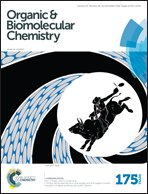Molecular binding behavior of water-soluble calix[4]arenes with asymmetric 4,4′-bipyridinium guests in aqueous solution: regioselective recognition or not?†
Abstract
The molecular binding behavior of water-soluble calix[4]arenes (p-sulfonatocalix[4]arene (SC4A) and p-sulfonatothiacalix[4]arene (STC4A)) with two asymmetric 4,4′-bipyridinium guests (N-methyl-N′-adamantane carbomethyl-4,4′-bipyridinium dibromide (MVAd2+) and N-methyl-N′-(naphthalen-2-ylmethyl)-4,4′-bipyridinium bromide iodide (MVNp2+)) was systematically studied using NMR spectroscopy and microcalorimetry in a neutral aqueous solution. Either the methyl group or the adamantane moiety in MVAd2+ could enter into the SC4A and STC4A cavities, without regioselectivity. The STC4A cavity can also accommodate MVNp2+, either through incorporation of the methyl group or the naphthalene moiety, without regioselectivity. However, we were surprised to find that MVNp2+ could only be included within the SC4A cavity through incorporation of the methyl group, with regioselectivity, which is rare for a flexible host. Furthermore, both SC4A and STC4A can form stable inclusion complexes with the two investigated asymmetric 4,4′-bipyridinium guests, driven by very favorable enthalpy changes, and the thermodynamic origins of the host selectivities for MVAd2+ and MVNp2+ can be well explained through their binding modes. The finding of this novel regioselective recognition is promising for potential applications in the development of more sophisticated biomimetic materials.
![Graphical abstract: Molecular binding behavior of water-soluble calix[4]arenes with asymmetric 4,4′-bipyridinium guests in aqueous solution: regioselective recognition or not?](/en/Image/Get?imageInfo.ImageType=GA&imageInfo.ImageIdentifier.ManuscriptID=C6OB02105K&imageInfo.ImageIdentifier.Year=2016)

 Please wait while we load your content...
Please wait while we load your content...